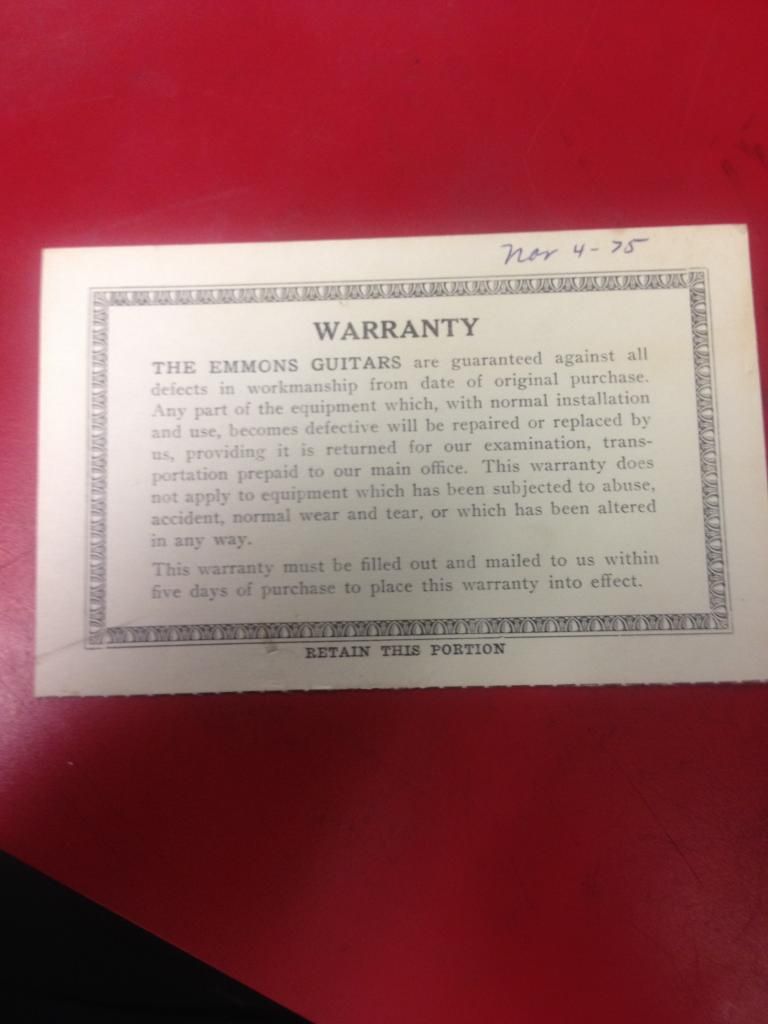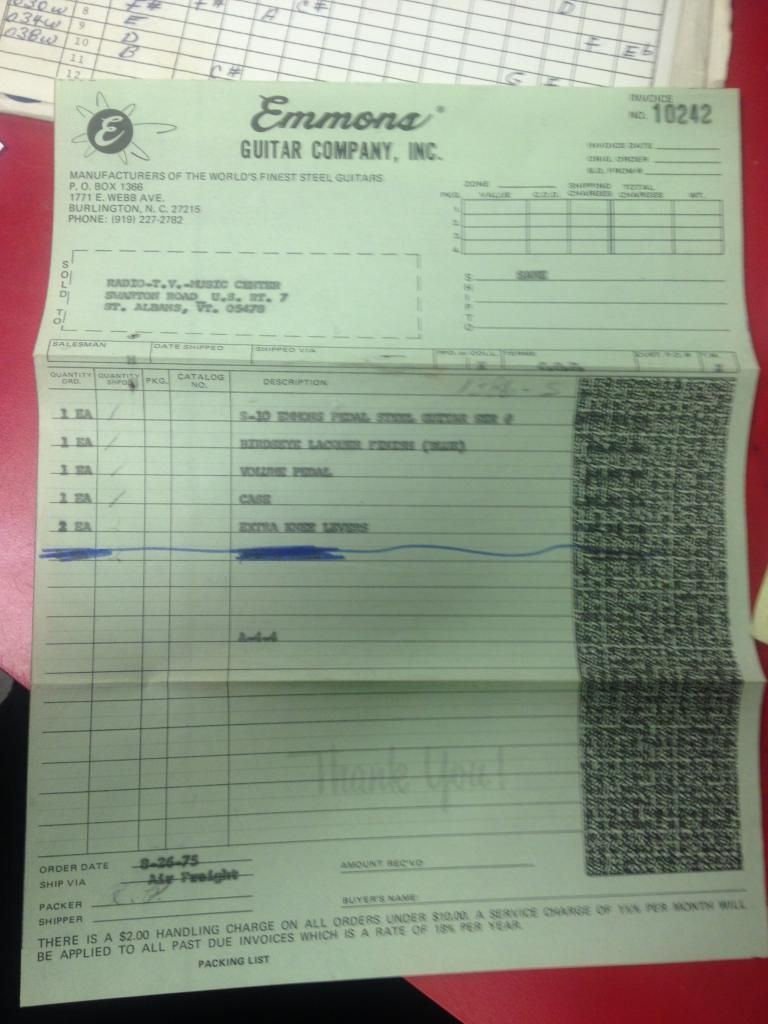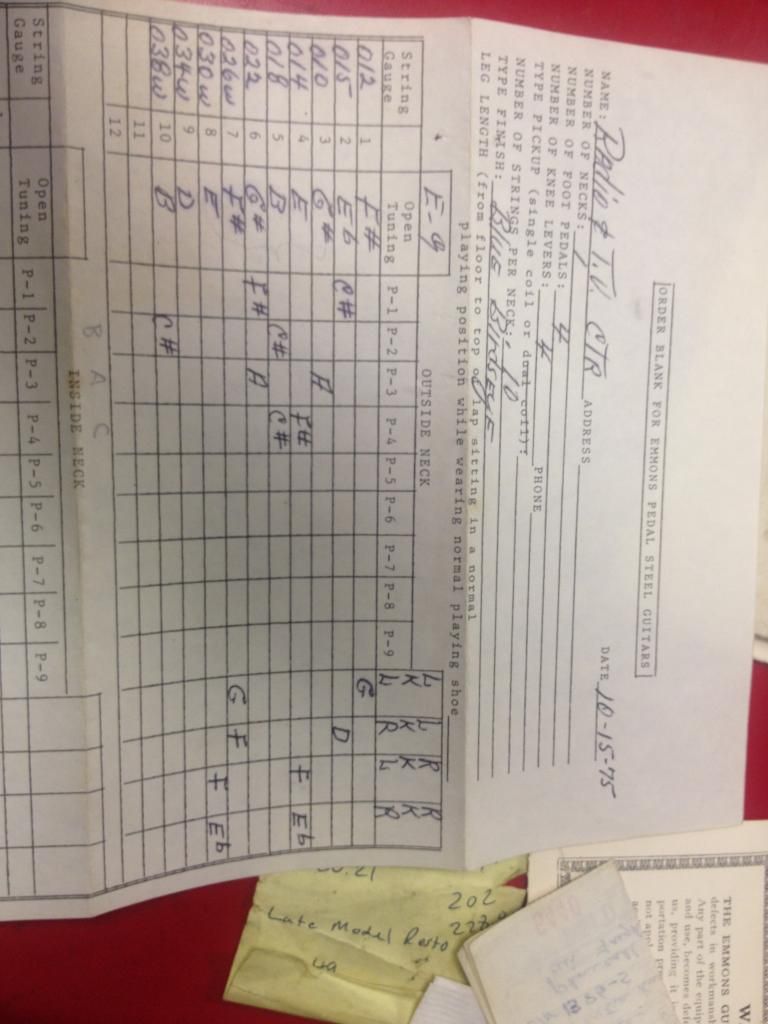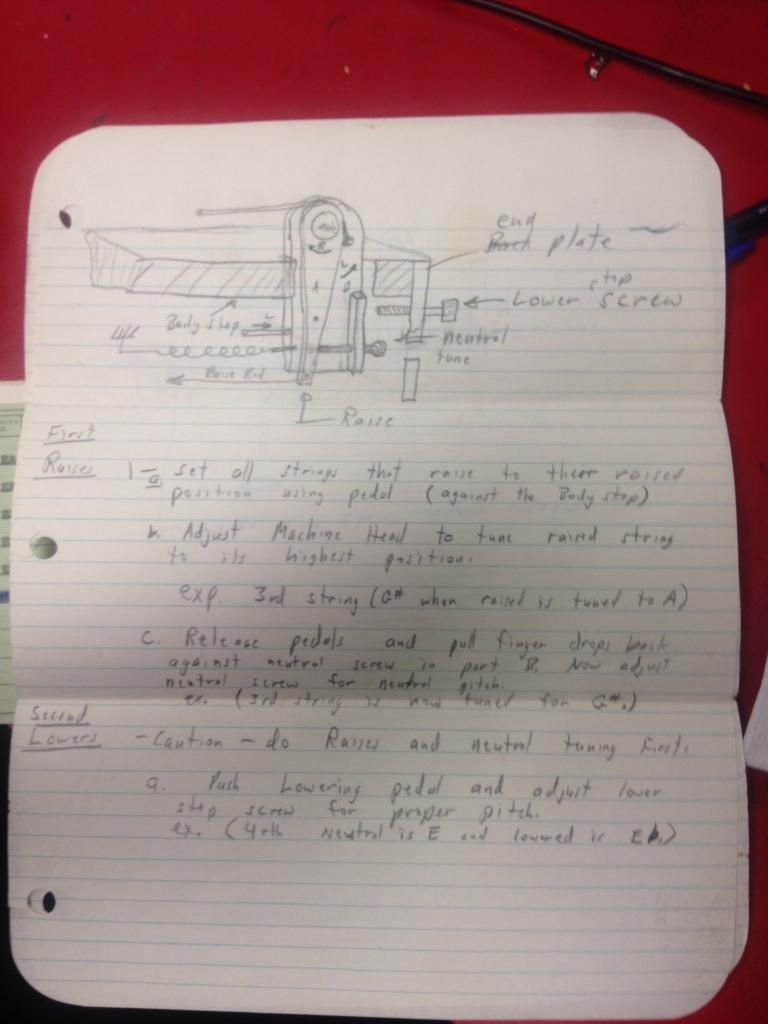Page 3 of 5
Posted: 6 Aug 2014 7:23 pm
by Tom Gorr
Thanks Godfrey for saving those pics...geez, the OP lives in steel guitar heaven it looks like, it would take 5 years in my part of the world to drum up that kind of cool and desirable gear. I'd have spent my yearly new gear funds three times over already.
Posted: 6 Aug 2014 8:23 pm
by Kevin Raymer
Nobody said playing steel guitar was cheap..
My wife is begging me to go back to playing golf...

Posted: 7 Aug 2014 3:02 am
by Godfrey Arthur
Tom Gorr wrote:Thanks Godfrey for saving those pics...geez, the OP lives in steel guitar heaven it looks like, it would take 5 years in my part of the world to drum up that kind of cool and desirable gear. I'd have spent my yearly new gear funds three times over already.
No problem Tom. I went through the same thing a few years back trying to figure out the same thing, so I figure a thread like this is important to keep going.
Posted: 9 Aug 2014 4:37 pm
by Peter Harrell
Ok, I bought the Emmons. Man, these things are HEAVY! The guy was the original owner, bought it in 1975 and barely played it at all. He had every piece of paperwork ever involved with the guitar. Original receipt, order form, etc. Pretty neat.
I'm just going to use this thread to keep track of my progress instead of starting a new one for every problem I have. Any help from you guys on figuring this thing out is greatly appreciated. I guess I'm off to youtube now to find some beginner stuff.
Posted: 9 Aug 2014 5:16 pm
by Tom Gorr
Huge congrats!
I thought if you didn't get this one, you'd be kicking yourself for years to follow...it should be clear sailing for you, and methinks if you treat that guitar like a museum piece, it will likely appreciate over the years to come.
Just a forewarning there can be some severely frustrating moments in the early years of learning basic technique. If it ever stops being 'fun', there's no crime in taking a small break. Information overload common on this thing.
Check out Joe Wright's steel guitar site:
www.pedalsteel.com.
Learn basic techniques from this guy, and you'll be out of the weeds in no time.
Posted: 9 Aug 2014 5:38 pm
by Lane Gray
Get this book, it helps a LOT
http://www.steelguitarshopper.com/produ ... Keith.html
Congratulations on a great axe. Welcome to an obsession
Posted: 9 Aug 2014 10:22 pm
by Herb Steiner
Peter, since you're in NC, get acquainted with Billy Knowles, he's on the Forum. If you need help with the guitar, he's the closest man I'd recommend.
You Lucky Dog.
Posted: 10 Aug 2014 4:29 am
by Tommy Auldridge
I for one am glad you decided on the Emmons. If you ever change your mind and want to sell it, let me know. There will never be enough of these to meet the demand. And of course, they're no longer made. Sure sounds like you got a real nice one. Tommy.......
Posted: 10 Aug 2014 9:27 am
by Peter Harrell
Thanks guys. A couple things... The guy have me a tuning sheet but the second string doesn't match what he has on the sheet. On the sheet it says b d e f# g# b e g# e flat f#. The second string on my guitar is a half tone flat. Which is correct?
Also, I'm a tall guy and I can't get my leg under the table and on the volume pedal. Can this be adjusted without causing a bunch of problems?
Posted: 10 Aug 2014 9:27 am
by Peter Harrell
Thanks guys. A couple things... The guy have me a tuning sheet but the second string doesn't match what he has on the sheet. On the sheet it says b d e f# g# b e g# e flat f#. The second string on my guitar is a half tone flat. Which is correct?
Also, I'm a tall guy and I can't get my leg under the table and on the volume pedal. Can this be adjusted without causing a bunch of problems?
Posted: 10 Aug 2014 9:50 am
by George Seymour
Peter Harrell wrote:Thanks guys. A couple things... The guy have me a tuning sheet but the second string doesn't match what he has on the sheet. On the sheet it says b d e f# g# b e g# e flat f#. The second string on my guitar is a half tone flat. Which is correct?
Also, I'm a tall guy and I can't get my leg under the table and on the volume pedal. Can this be adjusted without causing a bunch of problems?
Go see Billy Knowles, he can get you all the correct parts to raise your guitar to your proper height. He is in Kenansville, NC. Be wise for him to go over all your raises and lowers to be sure everything is timed correctly. Great Emmons man and Brother!
You won't be sorry.
Posted: 10 Aug 2014 9:51 am
by Richard Sinkler
Peter Harrell wrote:Ok, I bought the Emmons. Man, these things are HEAVY! The guy was the original owner, bought it in 1975 and barely played it at all. He had every piece of paperwork ever involved with the guitar. Original receipt, order form, etc. Pretty neat.
I'm just going to use this thread to keep track of my progress instead of starting a new one for every problem I have. Any help from you guys on figuring this thing out is greatly appreciated. I guess I'm off to youtube now to find some beginner stuff.
My opinion only. I would start other threads for specific issues. When a thread gets too long, people tend to not want to look at it again. I get that way, and I'm sure others do too.
Posted: 10 Aug 2014 10:09 am
by Richard Sinkler
Peter Harrell wrote:Thanks guys. A couple things... The guy have me a tuning sheet but the second string doesn't match what he has on the sheet. On the sheet it says b d e f# g# b e g# e flat f#. The second string on my guitar is a half tone flat. Which is correct?
Also, I'm a tall guy and I can't get my leg under the table and on the volume pedal. Can this be adjusted without causing a bunch of problems?
A lift kit is all you need to raise it up.
the tuning for the guitar, if it's an E9th tuning is: top to bottom F#, D#, G#, E, B, G#, F#, E, D, B.
And just a word on the pedal setup. I saw where someone posted that this has a "Day" setup. That means the 1st and 3rd pedals are switched opposite of what is an "Emmons" setup. This takes into account that the 4th pedal is to the right of the main 3. Don't let the fact that in instruction material, the pedals are listed in the order for the "Emmons" setup. Since the Emmons is a guitar that you really need someone real good to change the tuning around (and probably costly), I would advise you just learn it as is. There really isn't an advantage of one over the other. On an Emmons setup, the A pedal (B's to C#) is the left of the three main pedals. The B (G# to A) pedal on both is the next pedal (in between A & C). The C pedal (String 4 to F#, string 5 to C#) is the pedal to the right of the B pedal. Here are some visuals of just the 3 main pedals.
Emmons setup
[tab]
pedals A B C
F#
D#
G#.........A
E...............F#
B.....C#........C#
G#.........A
F#
E
D
B.....C#
[/tab]
Day Setup (presumably the way your guitar is set up)
[tab]
pedals C B A
F#
D#
G#........A
E.....F#
B.....C#......C#
G#........A
F#
E
D
B.............C#
[/tab]
Don't let anyone tell you that you can't use tab or lessons because your pedals are set up backwards from the more standard Emmons setup. Th C pedal does the same thing as the C pedal in the other tuning. Same for the A & B pedals.
Posted: 10 Aug 2014 11:28 am
by Tom Gorr
Peter Harrell wrote:Thanks guys. A couple things... The guy have me a tuning sheet but the second string doesn't match what he has on the sheet. On the sheet it says b d e f# g# b e g# e flat f#. The second string on my guitar is a half tone flat. Which is correct?
The first principle of steel guitar is that there is nothing set in stone. There's a myriad of almost standard tunings and slight variations of them based on personal preference, stylistic considerations, and genre conveniences.
In this case, your chart shows a standard E9 tuning, with the prior owner's preference to tune string 2 to D rather than D#. There are a number of players that have done this at one time in their career or other.
My own interpretation of why this would be useful is that, at least in my own playing, I often use the string 4 lower e-d# to reach the d# note rather than string 2, and the place I most often use string 2 pulled to D. is in a scale run with A+B down in the Five Chord position (+2 frets). I have to then hold a lever to get that note. If I had it tuned to D I wouldn't have to use a lever, and thus could use that lever for a different more useful change.
So you can see from the example that having a lever is sort of redundant with this approach.
That said, I have the standard tuning, but I wouldn't sweat the issue either way...there are 'compromises' because we only have enough limbs to run a certain number of pedals and levers.
Posted: 10 Aug 2014 11:43 am
by Herb Steiner
Peter
Yes, there are minor variations in particular players' tunings all over the population of steel players, but as a beginner you should... in my opinion based as a long-time teacher and publisher of steel courses... absolutely tune your 2nd string to the most common note D#.
Regardless of what other players may or may not do, there standard and accepted wisdom of that change is to tune the string as above, and lower it to either a D note, or a D and further to a C#. This is what all instructional materials utilize and what the overwhelming majority of players have on their guitars.
If you want to change any part of your basic tuning, it should come after learning the traditional vocabulary and methodology of the E9. And that will take some time.
Posted: 10 Aug 2014 11:46 am
by Lane Gray
The "normal" is for 2 to be D# tuned at the keyhead, with a lever lowering it to D (tuned with the "hidden" screw-the one that tunes 3 to G#), and continuing on to C#, which tunes with the screw that tunes the lowers (the D# note on the fourth string).
But there are SO many departures from standard that standard is more like "most common" than really "standard".
Jimmy Crawford, Terry Bethel and others tune it to D, with one lever raising it to D# and another lowering it to C#.
Posted: 10 Aug 2014 12:00 pm
by Herb Steiner
Peter, I don't know why I'm belaboring this point, because I don't have a dog in your educational hunt, but I will make this last comment for your benefit, IMHO.
Both what Tom Gorr and Lane said is true, there are variations in the copedents (pedal and tuning setup) of many pro level players. Whether "standard" is "most common" is simply parsing imprecise definitions.
But hey, Richie Havens played in an open tuning. John Fahey used drop-D tuning and others a lot, and Keith Richards plays a 5-string guitar. Would you tell someone just starting out on guitar that they really don't need to pay attention to the most common tuning because "nothing is set in stone?"
I wish you well in your journey with the steel. She is a jealous mistress.

Posted: 10 Aug 2014 12:08 pm
by Tom Gorr
I tend to agree that standard is the best place to start. Half turn of the tuner peg will get you there

Of course, this will effect any lever change that may also be on the string, so the impact of this change could accelerate one other learning experience: learning the mechanics of a push pull. You should probably publish the rest of your copedent chart, so we can understand what lever and pull train is affected.
Posted: 10 Aug 2014 1:32 pm
by Richard Sinkler
Tom... I think you misunderstood his tuning as I did. Traditionally, we start at string one and go to string ten. The way he wrote it, he started at the tenth string and progressed to string one. If we look at his listing as starting on string ten, then his tuning is standard. Fooled me too.
Posted: 10 Aug 2014 1:52 pm
by Tom Gorr
Ah, he's saying his ninth string is c#, rather than his second string at d...haha
Almost like E6/9 tuning but doesn't flow thru the small strings like others that pursue 9/6. This variation is also talked about by some, not common but not unheard of...
Posted: 10 Aug 2014 3:03 pm
by Eric Henry
Congratulations on the Emmons, Peter. You're about to have a whole lot of fun.
I just saw this thread today and the suspense was building as I clicked through each page. "Will Peter buy it?!"
(Idea: we need a steel guitar reality TV show like the ones where people buy houses. Except this one would have consternated forum members trying to decide if they should buy a U-12 or an old Sho-Bud.)
You got a great deal and I can't see how you'd ever regret it. After having a couple beginner steels over the last few years I finally saved my pennies and bought a 70s P/P Emmons earlier this summer. Love it. Wish I'd done it sooner and glad to see that you did.
This forum has been a tremendous help to me. And the coolest part is meeting these characters out in the real world. They're even nicer in person.
Posted: 10 Aug 2014 3:12 pm
by Tom Gorr
The drama for me was whether the guitar would mysteriously disappear, as I'm sure there were hundreds salivating. The restraint shown by the community to let this newbie get first dibs on it is nothing short of stunning.
Posted: 10 Aug 2014 5:30 pm
by Herb Steiner
Tom Gorr wrote:The drama for me was whether the guitar would mysteriously disappear, as I'm sure there were hundreds salivating. The restraint shown by the community to let this newbie get first dibs on it is nothing short of stunning.
+1
Posted: 11 Aug 2014 4:32 am
by Peter Harrell
Richard Sinkler wrote:Peter Harrell wrote:Ok, I bought the Emmons. Man, these things are HEAVY! The guy was the original owner, bought it in 1975 and barely played it at all. He had every piece of paperwork ever involved with the guitar. Original receipt, order form, etc. Pretty neat.
I'm just going to use this thread to keep track of my progress instead of starting a new one for every problem I have. Any help from you guys on figuring this thing out is greatly appreciated. I guess I'm off to youtube now to find some beginner stuff.
My opinion only. I would start other threads for specific issues. When a thread gets too long, people tend to not want to look at it again. I get that way, and I'm sure others do too.
I hear ya. Just don't want to pollute the site with a million newb threads. I'm sure once I get out of the first few weeks of this I won't be quite as needy and so far everybody has been super helpful.
Posted: 11 Aug 2014 4:42 am
by Peter Harrell



